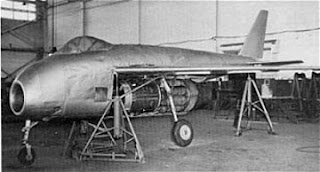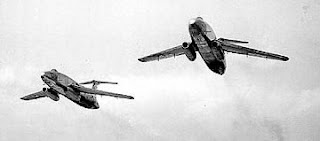Messerschmitt Me P.1101
The Me P.1101 was the first variable geometry jet fighter, although it‘s wing sweep could only be altered from 35 degrees to 45 degrees whilst the plane was on the ground. The two-piece wing had steel spars with wooden skin and ribs, and was located in the high-mid position. The tail surfaces were also swept. The pressurised cabin was located well forward in the upper part of the fuselage, and behind it was the fuel tank and space for the retracted main undercarriage legs. Below the cockpit was the air intake and duct for the turbojet engine, which was mounted in mid-fuselage.The P.1101‘s development started early in 1944. The Messerschmitt advanced design office was looking for a single-engined jet fighter with the same endurance and range as the successful Me 262. After wind tunnel testing, construction of an experimental prototype was initiated in July 1944 but only near completion when the Allies captured the airbase where the plane was being built. The P.1101 provided the fundamental design ideas for the American Bell X-5 variable sweep research aircraft.
 |
Front view of the reassembled Me P.1101 |
 |
Reassembled Me P.1101 after transfer to the US. |
 |
Me P.1101 near completion as captured by US troops. |
 |
Another Me P.1101 was captured in Oberammergau in May 1945. |
 |
Drawing of series productuction model. |
 |
Partly rebuilt captured Me P.1101 with mock-up canons. |
Nakajima J8N-1 „Kitsuka“
The project was launched in September 1944 when Nakajima was entrusted with the development of a single-seat two-engined jet plane based on the German Me 262. The jet was to be used in the fast bomber and ground attack role. In addition, the aircraft was to have folding wings to enable it to be hidden in caves and tunnels. The take off was to be assisted with two auxiliary external rockets (RATO) each with 450 kg (993 lb) of thrust. The engines used were Ne-20 turbojets which were hastily built, based on the data and characteristics of the German BMW 003 turbojet. Two prototypes were built in total between June and August 1945. The first prototype was completed by the beginning of August 1945 and on Tuesday 7 August, made it‘s maiden flight (one day after the nuclear bombing of Hiroshima). Four days later, the same aircraft had a serious accident with it‘s RATO packs. At the time the assembly lines were occupied , 18 other Kitsuka („Kikka“) aircraft were found in various stages of production.
Bell XP-59A Airacomet - America‘s first Jet Fighter
The Bell XP-59A Airacomet was America‘s first jet aircraft. With the XP-59A project being given the highest priority, work proceeded very rapidly. The Bell adopted a fairly conservative design approach. Within two months after the initial order, Bell engineers had submitted a design for a fairly conventional aircraft, with a cantilever, laminar-flow, mid-mounted wing and a fully-retractable tricycle landing gear. The aircraft was fitted with two 1400 lb. st. General Electric I-A jet engines. The jet engines were too heavy in relation to the amount of power they could develop, and their exhaust was so hot that the turbine blades regularly overheated and often broke off with catastrophic results. The maximum speed was 404 mph at 25,000 feet, somewhat below expectations. The third YP-59A was shipped to Britain in exchange for the first production Gloster Meteor.
 |
| The first XP-59A during a test flight. |
 |
| One of the later prototypes with nose canons in flight. |
 |
| XP-59A on lake bed. |
 |
| Rare color photo of the Airacomet. |
 |
| XP-59A # 3 which was later delivered to the RAF. |
Bell XP-83
The XP-83 was designed to overcome a major flaw the P-59 Airocomet, namely meager fuel load and thus short range. The XP-83 was constructed along the same lines as the P-59 though in a much more portly fashion. Performance was disappointing at best and the project was eventually abandoned.
Martin XB-48
Several innovations were tried in the Martin XB-48. Its two huge nacelles, each housing three jet engines, were themselves designed as lifting bodies; internal air ducts between the engines were supposed to channel the airstream. The wings were extremely thin for low drag at high speed. The first XB-48 made its first flight on June 22, 1947, a 37-minute hop to Patuxent River Naval Air Station. Tests at Patuxent River were disappointing. The XB-48‘s top speed was only 516 mph at 20,000 feet, 479 at the design altitude of 35,000. In October the second prototype Martin XB-48, its weight duly brought down to specification first flew. It was used to test equipment for its successful competitor, the Boeing B-47.
Martin XB-51
The XB-51 project originated in an Army Air Forces design competition in February 1946. After disappointing results with the
„conventional“ design of the XB-48, Martin produced a strikingly innovative airplane in the XB-51. Two prototype XB-51‘s were
first flown and tested in late 1949 and early 1950, just before the outbreak of war in Korea. The XB-51 had a crew of only two:
a pilot and an operator for the navigation and bombing system. It could carry up to 10,495 pounds of bombs and eight forward-firing
20 millimeter cannon. The project was cancelled in 1951. The two prototypes continued to fly by participating in tests of their
advanced aerodynamic and weapons-handling features. Both were eventually lost in crashes laid to pilot error.
 |
Interesting view of the rear engine and innovative T-tail layout. |
 |
The XB-51 was one of the most advanced medium attack bomber projects of its time . |
 |
The two prototypes in formation flight. |
 |
Unusual forward engine configuration.. |
 |
The wings in max. 7° up-angle position (variable-incidence). |
 |
A very clean design! |
 |
Rocket assisted take off. |
_________________________________________________________________
Prototypes
Ames-Dryden AD-1
The idea of an aircraft utilizing the wing swiveling about the vertical axis dates back to WWII times, when Dr. Richard Vogt of Blohm & Voss company proposed the BV P.202 fighter project in 1944. The aerodynamic benefits of such concept are evident: it is ideal for low speeds in straight position and for high speeds in „skew“ position. The unique wing was demonstrated on a small, subsonic jet-powered research aircraft called the AD-1 (Ames Dryden -1). The aircraft was flown 79 times during the research program. Powered by two small turbojet engines, each producing 220 pounds of static thrust at sea level, the aircraft was limited for reasons of safety to a speed of about 170 mph. It was constructed of plastic reinforced with fiberglas. The final flight of the AD-1 did not occur at Dryden, however, but at the Experimental Aircraft Association‘s (EAA) annual exhibition at Oshkosh, WI, where it was flown eight times to demonstrate its unique configuration.
 |
| AD-1 flying with wing swiveled to 30°. |
 |
| Flying at high speed with wing pivot angle of 60°. |
 |
| Wing perpendicular to the fuselage for take-off and landing. |
 |
| Wing with maximum oblique angle of 60°. |
 |
| The wing could be swiveled between 0° and 60° |
 |
| BV P.202 oblique wing fighter project of 1944. |
Rockwell XFV-12
Rockwell International‘s XFV-12A was a supersonic fighter/attack „Thrust Augmenter Wing“ concept. The design used a modified 30,000 lb thrust Pratt & Whitney F401 engine. For vertical lift, a diverter valve in the engine exhaust system blocked the nozzle and directed the gases through ducts to ejector nozzles in the wings and canards for vertical lift. An auxiliary engine inlet for use in vertical flight was located immediately behind the cockpit. The prototype aircraft used parts from the A-4 and F-4; the fuselage was 44 ft long with a 28.5 ft wingspan and a 12 ft canard span. Operational vertical take-off weight was expected to be 19,500 lb, with a maximum speed of over Mach 2 anticipated by Rockwell. Engine rig testing began in 1974, aircraft ground testing in July 1977. Only one of two contracted aircraft were completed. Differences from the lab models to the full scale system caused the actual augmentation to be only 19% for the wing and 6% for the canard. The thrust available for vertical flight was insufficient to permit powered-lift flights. The aircraft never made it into the air - not even for a test flight under conventional power. Lift improvement testing and plans to modify the ejector/augmentor system were discontinued in 1981 due to cost overruns and waning Navy V/STOL interest.
 |
| XFV-12 hooked to a crane to find out why she refused to take-off. |
 |
| Illustration showing the thrust augmenter wing concept. |
 |
| 30,000lb thrust Pratt & Whitney F401 powerplant with ducts on test stand. |
 |
| Rear view showing the blocked engine exaust nozzle for VTOL. |
 |
| The prototype #1 in the look of a fully operational aircraft in front of the never completed second prototype. |
 |
| Form performes function - but the XFV-12 was a sitting duck. |






























